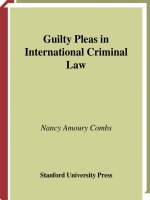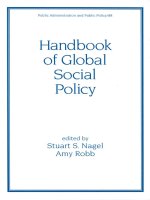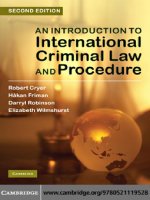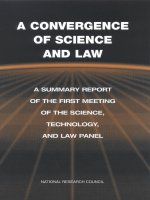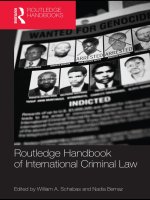Routledge Handbook of International Criminal Law pot
Bạn đang xem bản rút gọn của tài liệu. Xem và tải ngay bản đầy đủ của tài liệu tại đây (2.71 MB, 476 trang )
Routledge Handbook
of International
Criminal Law
International criminal law has developed extraordinarily quickly over the last decade, with the
creation of ad hoc tribunals for the former Yugoslavia and Rwanda, and the establishment of a
permanent International Criminal Court. This book provides a timely and comprehensive
survey of emerging and existing areas of international criminal law.
The Handbook features new, specially commissioned papers by a range of international and leading experts in the field. It contains reflections on the theoretical aspects and contemporary
debates in international criminal law.
The book is split into four parts for ease of reference:
•
•
•
•
The Historical and Institutional Framework—Sets international criminal law firmly in
context with individual chapters on the important developments and key institutions which
have been established.
The Crimes—Identifies and analyses international crimes, including a chapter on aggression.
The Practice of International Tribunals—Focuses on topics relating to the practice and
procedure of international criminal law.
Key Issues in International Criminal Law—Goes on to explore issues of importance
such as universal jurisdiction, amnesties and international criminal law and human rights.
Providing easy access to up-to-date and authoritative articles covering all key aspects of international criminal law, this book is an essential reference work for students, scholars and practitioners
working in the field.
William A. Schabas is director of the Irish Centre for Human Rights at the National
University of Ireland, Galway, where he also holds the chair in human rights law.
Nadia Bernaz is Lecturer in Law at Middlesex University, London.
Routledge Handbook
of International
Criminal Law
Edited by William A. Schabas
and Nadia Bernaz
First published 2011
by Routledge
2 Park Square, Milton Park, Abingdon, Oxon, OX14 4RN
Simultaneously published in the USA and Canada
by Routledge
270 Madison Avenue, New York, NY 10016
Routledge is an imprint of the Taylor & Francis Group, an informa business
This edition published in the Taylor & Francis e-Library, 2011.
To purchase your own copy of this or any of Taylor & Francis or Routledge’s
collection of thousands of eBooks please go to www.eBookstore.tandf.co.uk.
© 2011 editorial matter and selection: William A. Schabas and Nadia Bernaz,
individual chapters: the contributors.
All rights reserved. No part of this book may be reprinted or reproduced or
utilised in any form or by any electronic, mechanical, or other means, now
known or hereafter invented, including photocopying and recording, or in
any information storage or retrieval system, without permission in writing
from the publishers.
British Library Cataloguing in Publication Data
A catalogue record for this book is available from the British Library
Library of Congress Cataloging in Publication Data
Routledge handbook of international criminal law / edited by William
Schabas and Nadia Bernaz.
p. cm.
ISBN 978-0-415-55203-5 (hbk) – ISBN 978-0-203-83689-7 (ebk)
1. International criminal courts. 2. International offenses. I. Schabas,
William, A. 1950– II. Bernaz, Nadia. III. Title: Handbook of international
criminal law.
KZ6304.R68 2011
345–dc22
2010022449
ISBN 0-203-83689-8 Master e-book ISBN
ISBN13: 978-0-415-55203-5 (hbk)
ISBN13: 978-0-203-83689-7 (ebk)
Contents
Acknowledgements
Contributors
Introduction
William A. Schabas and Nadia Bernaz
ix
xi
1
PART I
Historical and institutional framework
1 Trial at Nuremberg
Guénaël Mettraux
3
5
2 The Tokyo Trial
Neil Boister
17
3 The trials of Eichmann, Barbie and Finta
Joseph Powderly
33
4 The ad hoc international criminal tribunals: launching
a new era of accountability
Michael P Scharf and Margaux Day
.
51
5 The International Criminal Court
David Scheffer
67
6 Hybrid tribunals
Fidelma Donlon
85
PART II
The crimes
7 Genocide
Paola Gaeta
107
109
v
Contents
8
Crimes against humanity
Margaret M. deGuzman
121
9
War crimes
Anthony Cullen
139
10 Aggression
Nicolaos Strapatsas
155
11 Terrorism as an international crime
Fiona de Londras
169
12 Drug crimes and money laundering
Robert Cryer
181
PART III
The practice of international tribunals
195
13 Understanding the complexities of international
criminal tribunal jurisdiction
Leila Nadya Sadat
197
14 Admissibility in international criminal law
Mohamed M. El Zeidy
211
15 Defences to international crimes
Shane Darcy
231
16 Participation in crimes in the jurisprudence of the
ICTY and ICTR
Mohamed Elewa Badar
247
17 International criminal procedures: trial and appeal procedures
Hakan Friman
˚
271
18 Sentencing and penalties
Nadia Bernaz
289
19 State cooperation and transfers
Kimberly Prost
305
20 Evidence
Nancy Amoury Combs
323
vi
Contents
PART IV
Key issues in international criminal law
335
21 The rise and fall of universal jurisdiction
Luc Reydams
337
22 Immunities
Rémy Prouvèze
355
23 Truth commissions
Eric Wiebelhaus-Brahm
369
24 State responsibility and international crimes
Eric Wyler and León Arturo Castellanos-Jankiewicz
385
25 International criminal law and victims’ rights
Carla Ferstman
407
26 Amnesties
Louise Mallinder
419
27 International criminal law and human rights
Thomas Margueritte
435
Conclusions
William A. Schabas and Nadia Bernaz
453
Index
455
vii
Acknowledgements
The editors are grateful to Victoria J. Moore who reviewed most of the manuscript and made
constructive suggestions. We remain responsible for all the errors that may be found in this book.
ix
Contributors
Mohamed Elewa Badar is a Lecturer in Law and Deputy Director, Centre for International
and Public Law, Brunel Law School, Brunel University, London. He is the author of Mens Rea in
International Criminal Law (Oxford: Hart, December 2010).
Nadia Bernaz (PhD, Aix-Marseilles III, France) is Lecturer in Law at Middlesex University,
London (UK) and Adjunct Lecturer of the Irish Centre for Human Rights (NUI Galway,
Republic of Ireland). She is the author of Le droit international et la peine de mort (International
Law and the Death Penalty, Paris: La Documentation franỗaise, 2008) and has written and
presented papers on a wide range of subjects in international law and human rights law.
Neil Boister BA, LLB, LLM (Natal), PhD (Nottingham) joined the University of
Canterbury (New Zealand) from the University of Nottingham at the beginning of 2003.
He teaches and researches in criminal law, international criminal law and transnational criminal
law.Together with Professor Robert Cryer of the University of Birmingham he is the co-author
of The Tokyo International Military Tribunal, A Reappraisal (Oxford University Press, 2008) 382 pp
and co-editor of Documents on the Tokyo International Military Tribunal (Oxford University Press,
2008) 1568 pp.
León Arturo Castellanos-Jankiewicz is Licenciado en Derecho (Universidad Anáhuac
Mayab, Mexico), and holds a Master in International Law from the Graduate Institute of International and Development Studies in Geneva. He is currently a PhD candidate at the Amsterdam
Centre for International Law.
Nancy Amoury Combs is the Cabell Professor of Law at William and Mary Law School. She
earned her JD from the University of California at Berkeley School of Law and her PhD from
Leiden University. She has published extensively on topics of international criminal law.
Robert Cryer is Professor of International and Criminal Law at the University of Birmingham.
He is the author, inter alia, of Prosecuting International Crimes (Cambridge, 2005), The Tokyo International Military Tribunal: A Reappraisal (Oxford University Press, 2008)(with Neil Boister) and
An Introduction to International Criminal Law and Procedure (Cambridge, 2nd ed, 2010)(with Håkan
Friman, Darryl Robinson and Elizabeth Wilmshurst).
Anthony Cullen BA, MA, LLM, PhD is a Researcher on the joint British Red Cross and
International Committee of the Red Cross (ICRC) project to update the collection of practice
underlying the ICRC’s Study on Customary International Humanitarian Law. He is also a
xi
Contributors
Research Fellow at the Lauterpacht Centre for International Law and a Visiting Fellow at Wolfson
College, University of Cambridge. His book The Concept of Non-International Armed Conflict in
International Humanitarian Law was published by Cambridge University Press in April 2010.
Shane Darcy LLM, PhD is a lecturer at the Irish Centre for Human Rights, National
University of Ireland, Galway. He is the associate editor of Criminal Law Forum and the author of
Collective Responsibility and Accountability under International Law (Transnational, 2007).
Margaux Day is a federal judicial clerk for Judge Solomon Oliver, Jr, Federal District
Court for the Northern District of Ohio, and is an Adjunct Professor at Case Western Reserve
University School of Law. She was a member of the 2008 Philip C. Jessup International Moot
Court World Champion Team.
Fidelma Donlon was Deputy Registrar of the Bosnian War Crimes Chamber and former
Head of the Criminal Institutions and Prosecutorial Reform Unit in the Office of the High
Representative. She was advisor to the Special Court for Sierra Leone on its residual issues and
its residual court and the British Institute for International and Comparative Law on the ‘Armed
Conflict and Transitional Justice Law as a Solution’ EU project. She is a PhD candidate at the
Irish Centre for Human Rights, National University of Ireland.
Margaret M. deGuzman is Assistant Professor of Law, Temple University Beasley School of
Law. Professor deGuzman teaches and writes about international criminal law and was a legal
advisor to the Senegal delegation at the Rome Conference on the International Criminal
Court.
Fiona de Londras BCL, LLM, PhD (NUI) is a lecturer in the School of Law, University College Dublin, where she is also affiliated with the Institute of Criminology. She has published on
terrorism and counter-terrorism in journals such as the Oxford Journal of Legal Studies, Modern
Law Review and Israel Law Review.
Mohamed M. El Zeidy (PhD, National University of Ireland, Galway) is a Legal Officer at the
Pre-Trial Division of the International Criminal Court. Prior to his current position, he served
as a judge and senior public prosecutor in Egypt (1997–2007). He is widely published in international criminal law, the author of The Principle of Complementarity in International Criminal Law
(Martinus Nijhoff, 2008) and co-editor of The ICC and Complementarity from Theory to Practice
(Cambridge University Press, 2010).
Carla Ferstman is Director of REDRESS (www.redress.org).
Håkan Friman is Deputy Director-General at the Swedish Ministry of Justice, Division for
Criminal Cases and International Judicial Cooperation. He is visiting Professor at University
College London, Faculty of Laws, a Member of the Swedish ICC Delegation and the co-author
of An Introduction to International Criminal Law and Procedure (Cambridge: Cambridge University
Press, 2nd edn, 2010).
Paola Gaeta is full Professor at the Law Faculty of the University of Geneva, Adjunct Professor
at the Graduate Institute of International and Development Studies and Director of the LLM
Programme of the Geneva Academy of International Humanitarian Law and Human Rights.
xii
Contributors
Her publications include The Rome Statute of the International Criminal Court (ed. with
A. Cassese and J. R. W. D. Jones), 2002, and The UN Genocide Convention. A Commentary
(ed,). 2009.
Louise Mallinder is a lecturer at the Transitional Justice Institute, University of Ulster. She has
published her doctoral thesis as Amnesty, Human Rights and Political Transitions: Bridging the Peace
and Justice Divide (Hart Publishing, 2008) and this monograph was awarded the 2009 Hart SLSA
Early Career Award and was jointly awarded the 2009 British Society of Criminology Book
Prize. Before starting the lectureship in November 2009, Louise worked as a research fellow on
a two-year AHRC-funded research project which investigated the impact of amnesty laws
within Argentina, Bosnia-Herzegovina, South Africa, Uganda and Uruguay.
Thomas Margueritte is a PhD candidate at the Centre de Recherches Internationales et
Communautaires of the Université Paul Cézanne (Aix Marseille III, France). His research
interests are international criminal law, international humanitarian law and human rights. Prior
to this, he was a fellow of the Court of Bosnia Herzegovina.
Guénaël Mettraux appears as counsel and consultant before international criminal jurisdictions.
He is a guest Professor at the University of Leiden and at the Academy of Humanitarian
Law (Geneva) and has published extensively, including three books published by Oxford
University Press.
Joseph Powderly is Researcher in International Criminal and International Humanitarian Law
at the TMC Asser Instituut, The Hague. He is a PhD candidate at the Irish Centre for Human
Rights, and was awarded a Government of Ireland Postgraduate Scholarship in 2008. He is a
contributor and co-editor with Dr Shane Darcy of Judicial Creativity in International Criminal
Tribunals, which will be published by Oxford University Press in 2010.
Kimberly Prost is an ad litem judge at the ICTY. She was formerly Chief of the Legal Advisory
Section UNODC, Head of Criminal Law Section Commonwealth Secretariat and Head of
Canadian International Assistance Group. She was a member of the Canadian delegation for
the negotiation of the Rome Statute and she is the author of several publications on the ICC,
international criminal law and international cooperation in criminal matters.
Rémy Prouvèze is a researcher at the Centre d’Etudes et de Recherches Internationales et
Communautaires (CERIC) in Aix-en-Provence (France). Specializing in public international
law and international criminal law (publishing several papers in these fields), he was awarded a
PhD for his study on Immunity from Criminal Jurisdiction of State Authorities in International Law at
the Université Paul Cézanne in Aix-en-Provence in 2006.
Luc Reydams is an Associate Professional Specialist in the Department of Political Science at
the University of Notre Dame. He is the author of Universal Jurisdiction: International and Municipal Legal Perspectives (Oxford: Oxford University Press, 2003) and the editor of the Global Activism
Reader (forthcoming with Continuum Publishing).
Leila Nadya Sadat is the Henry H. Oberschelp Professor of Law and Director of the Whitney
R. Harris World Law Institute at the Washington University School of Law (USA). The author
of more than 50 articles and several books, and the recipient of several academic prizes, Professor
xiii
Contributors
Sadat is well-known for her work in international criminal law and human rights. Professor
Sadat holds leadership positions in several learned societies, has served as a Commissioner on the
United States Commission for International Religious Freedom, and will serve as the Alexis de
Tocqueville Distinguished Fulbright Chair (Paris, France) in Spring 2011.
William A. Schabas is director of the Irish Centre for Human Rights at the National University of Ireland, Galway, where he holds the chair in human rights law. He is also a Global Legal
Scholar at the University of Warwick, in the United Kingdom, and honorary professor at the
Chinese Academy of Social Sciences, in Beijing. He is the author of more than 20 books and
275 journal articles, on such subjects as the abolition of capital punishment, genocide and the
international criminal tribunals. Professor Schabas was a member of the Sierra Leone Truth and
Reconciliation Commission. He is the chairman of the Board of Trustees of the United Nations
Voluntary Fund for Technical Cooperation in Human Rights. He is an Officer of the Order of
Canada and a member of the Royal Irish Academy.
Michael P. Scharf is the John Deaver Drinko-Baker & Hostetler Professor of Law, and
Director of the Frederick K. Cox International Law Center, at Case Western Reserve University
School of Law. He is also Managing Director of the Public International Law & Policy Group,
an NGO that provides pro bono legal assistance to governments and international tribunals
related to prosecution of war crimes.
David Scheffer is the Mayer Brown/Robert A. Helman Professor of Law and Director
of the Center for International Human Rights at Northwestern University School of Law,
Chicago, Illinois. He was the US Ambassador at Large for War Crimes Issues from 1997
to 2001.
Nicolaos Strapatsas (LLB UQAM, LLM NUIG) is a doctoral Candidate at the Irish Centre
for Human Rights (National University of Ireland, Galway) and a lecturer at the University of
Quebec at Montreal. He also is the associate editor of Criminal Law Forum.
Eric Wiebelhaus-Brahm is currently a Senior Research Fellow at the International Human
Rights Law Institute at DePaul University. His publications include Truth Commissions and
Transitional Societies:The Impact on Human Rights and Democracy (Routledge, 2010).
Eric Wyler is Professor of International Law and has taught at the following Universities:
Neuchâtel, Lausanne, Geneva, Paris II-Pantheon Assas and Paris I-Sorbonne (Visiting Professor).
He currently is associated Professor at SciencesPo, Paris, Chargé d’enseignement at the Graduate
Institute of International Studies (HEID), Geneva, and at the European Institute of the University
of Geneva. He is the author of L’illicite et la condition des personnes privées (1995), L’éthique du droit
international (1997, with Alain Papaux), L’extranéité ou le dépassement de l’ordre juridique étatique
(1999, Wyler-Papaux, ed.).
xiv
Introduction
William A. Schabas and Nadia Bernaz
The chapter headings of this handbook provide a good indication of the meaning of the term
‘international criminal law’. Nevertheless, it is not a simple matter to furnish a succinct definition. The French language distinguishes between droit international pénal and droit pénal international. The difference between the two terms seems to reside largely in the types of crimes
they address.Thus, droit pénal international refers to a body of law governing relationships between
states in the suppression of so-called ordinary crimes, such as murder and rape, as well as organized criminal activity when it takes on an international dimension. By contrast, droit international
pénal is focussed on crimes that are international in nature, generally because of their crossborder or transnational dimensions. Piracy is the classic example.
But when today’s lawyers and specialists talk of ‘international criminal law’, they are rarely
talking about piracy. Rather, the focus is on crimes that are also, by and large, gross and systematic
violations of human rights: genocide, crimes against humanity and war crimes.The acts underlying these offences, which are said to ‘shock the conscience of humanity’, have been perpetrated
since the beginning of human society. However, their codification as international crimes is a
recent phenomenon.
The first efforts at defining international war crimes were made at the Paris Peace Conference in 1919. There is a list in the report of the Commission on Responsibilities that includes
murders, torture, rape and the murder (but not the taking) of hostages, as well as acts that today
would not figure in a list of international crimes, such as destruction of fishing boats and poisoning of wells. The post-world war period was only a foretaste. The first really dynamic period
began in the final months of the Second World War. It brought with it a recognition of three new
categories of international crime: genocide, crimes against humanity and crimes against peace.
The international military tribunals that sat at Nuremberg and Tokyo were the first truly international trials. But in the early 1950s, it all ground to a halt.
International criminal law went through its great renaissance in the 1990s. This exciting
period is still continuing, and there is no end in sight. It has brought with it new institutions,
most of them temporary, but also a permanent addition: the International Criminal Court. The
definitions of crimes have been fine-tuned and refreshed. Moreover, the field has become more
complex to the extent that it actively involves national justice systems. It is associated with a
concept known as transitional justice, which views criminal accountability for atrocity as
1
Introduction
a necessary stage as states recover from conflict, and especially civil wars. The dynamism of
international criminal law is in large part associated with growth and excitement in two cognate
areas—international human rights law and international humanitarian law (the law of armed
conflict).
Eminent scholars in this new discipline have contributed the chapters in this handbook. It is
intended to provide readers with an accessible introduction to the field, and a guide to further
research. It may serve as both a reference volume and a textbook and is divided into four parts.
Part I sets the scene by presenting past experiences—the Nuremberg and Tokyo Trials and a
selection of domestic trials involving crimes committed during the Second World War—as well
as contemporary institutions: the permanent International Criminal Court and temporary tribunals, purely international and hybrid. Part II presents the crimes, focusing on the ‘core’ crimes—
genocide, crimes against humanity and war crimes—but also dedicating specific
chapters to aggression, the crime of terrorism and other crimes such as drug trafficking and
money laundering. Part III aims at portraying the practice of international tribunals and covers
the issues of jurisdiction, admissibility, procedure and evidence. It also goes into the different
modes of participation in crimes, defences and sentencing. Finally, Part III examines the key
issues of state cooperation and transfers. In Part IV, the last of the book, the authors explore a
selection of relevant issues in the field of international criminal law and, more largely, postconflict justice: universal jurisdiction, immunities, truth commissions, state responsibility and
international crimes, victims’ rights, amnesties and a chapter on international criminal law and
human rights.
2
Part I
Historical and institutional
framework
1
Trial at Nuremberg
Guénaël Mettraux
The road to Nuremberg, in short
The Second World War witnessed the commission of crimes of unprecedented brutality and
scale. The magnitude and cruelty of these events presented a challenge to the Allied leaders
charged with determining the fate of those thought to be responsible for these crimes. Given
their nature, it was agreed that they could not go unpunished. However, the choice of means and
methods of punishment was far from self-evident. As one author pointed out, ‘[t]he “law” of
an armistice or a treaty is, in the final analysis, the will of the victor’. Hence, the Allied Powers
considered a whole range of political and executive responses that did not involve any legal or
judicial elements.1 However, neither retaliation nor brutal reprisal were capable of bringing a
sense of justice to victims whilst at the same time helping to restore peace to the continent.2
The view that eventually prevailed was that those suspected of committing these crimes should
be subject to a judicial process that would investigate and pass judgment on their individual
responsibility. Henry Stimson understood too well the symbolic value of giving the defendants
rights and privileges associated with a genuine judicial process that they had denied so systematically
to those who had opposed them:‘We gave to the Nazis what they had denied their own opponents—
the protection of the Law’.3 In that sense, what would become the Nuremberg Tribunal was not
intended to be an instrument of vengeance, ‘but the reverse’.4
The fact that the decision to subject the accused to a judicial process might have been
motivated as much by laudable ideals of justice as by the lack of appeal of the alternatives5 should
not detract from the extraordinary advance that this decision represented:
It is the virtue of the Nuremberg trial that it was conceived in hatred of war, and was
nurtured by those starved of peace. To realize how grateful we should be for this birth,
consider the alternative.6
In some ways, the decision to punish these crimes after a criminal trial was born of the failure to
do so after the First World War, a bitter lesson not lost on the Allied Powers.7 And so, the idea that
the Nazi leaders should be put on trial grew ever more popular over the course of the war.8
Already, on 25 October 1941, Churchill had announced that ‘[r]etribution for these crimes must
5
Guénaël Mettraux
henceforward take its place among the major purposes of the war’.9 A few months later, representatives of nine occupied countries adopted the Declaration of St James Palace, which placed
among the Allied’s ‘principal war aims’ the following:
the punishment, through the channel of organized justice, of those guilty and responsible for
these crimes, whether they have ordered them, perpetrated them or in any way participated
in them, [and to] determine in a spirit of international solidarity to see to it that (a) those
guilty and responsible, whatever their nationality, are sought for, handed over to justice and
judged, (b) that the sentences pronounced are carried out.
President Roosevelt of the United States echoed this Declaration, saying that those responsible
for these crimes ‘shall have to stand in courts of law . . . and answer for their acts’.10 Shortly thereafter, on 7 October 1942, the United Nations War Crimes Commission was created to gather
and collect information regarding the commission of and responsibility for these international
crimes.11 The push towards a judicial response to these atrocities continued to gain momentum
and, on 30 October 1943, the leaders of the United States, the United Kingdom, and the USSR
adopted a Statement on Atrocities, which formed part of the Moscow Declaration and provided
as follows:
At the time of granting any armistice to any government which may be set up in Germany,
those German officers and men and members of the Nazi Party who have been responsible
for or have taken a consenting part in the above atrocities, massacres and executions will be sent
back to the countries in which their abominable deeds were done in order that they be
judged and punished according to the laws of these liberated countries of free governments
which will be erected therein. . . . The above declaration is without prejudice to the case of
German criminals whose offenses have no particular geographical localization and who will
be punished by joint decision of the government of the Allies.12
As the war was nearing its end, representatives of the same three great powers, plus France, sat
down to negotiate the terms of what would eventually become the Charter of an international
criminal tribunal based in Nuremberg, Germany. These negotiations were not without their
problems, as differences of views as to the purpose of the trial and the procedures to be applied
led to lengthy and sometimes quite acrimonious exchanges between the four sets of negotiators.13 What the delegates faced, Justice Robert H. Jackson is recorded as saying, was ‘the legal
equivalent of drafting the Ten Commandments’.14 But on 8 August 1945, the governments of the
four negotiating powers eventually signed the London Agreement, which provided for the
creation of an International Military Tribunal for the trial of war criminals ‘whose offences have
no particular geographical location whether they may be accused individually or in their capacity
as members of organizations or groups or in both capacities’.15 With this agreement, the four
Signatories had given life to an ad hoc, military, and international criminal tribunal, which was to
apply a mostly new set of rules and principles to exceptional events.16 The constitution, jurisdiction,
and functions of the Tribunal were set out in the Charter of the Tribunal, which was annexed to
the Agreement.17
The adoption of the London Agreement was itself quite a feat of politics and diplomacy as it
would prove to be one of the last significant international agreements of that era between a
group of countries that would soon become opponents in the Cold War. From a legal perspective,
too, the adoption of the Agreement and the Charter was a commendable achievement.18 That
achievement was the creation of a genuinely international body of criminal law capable of
6
Trial at Nuremberg
universal application that brought together several different legal traditions. ‘The significance of
the international character of the Nuremberg and Tokyo tribunals’, Nuremberg Prosecutor
Telford Taylor noted, ‘was a recognition of the inadequacy of single-nation courts for authoritative interpretations of international law, and the necessity of establishing an international jurisdiction and working acceptable international procedures if international penal law was to develop
at all satisfactorily’.19 However, as he himself noted, the international character of that process
was also one of its main weaknesses, as it amplified the legal ‘exceptionalism’ of the Nuremberg
Tribunal and its successors:
The shortcoming of the tribunals was that, although international, they were unilateral; they
were constituted by the victor nations and had jurisdiction only over the vanquished, and
this circumstance has remained a negative factor in subsequent evaluation of the trials.20
Some, indeed, decried what they saw as victor’s justice—political vengeance under the cloak
of justice.21 Victory, however, in its military form, was a condition of justice.22 What could be
criticized is not the manner in which justice was delivered at Nuremberg, which most agree was
fair, but the fact that the mandate of the judicial institution that was tasked to deliver justice was
so openly selective and one-sided.
The Nuremberg Charter and Nuremberg Tribunal
Whilst some claimed that the Charter of the Nuremberg Tribunal merely codified existing
principles, others were more forthcoming in acknowledging that, in fact, a great deal of it was
new law. Before the Charter had even been adopted, Glueck had acknowledged the need for the
law to grow to meet the demands of the day:
In a relatively undeveloped and plastic field of law it is but following an historical process to
blend ‘political’ with legal concepts in stimulating the growth of standards and principles.
Much of the law of nations has its roots in custom. Custom must have a beginning; and
customary usages of States in the matter of national and personal liability for resort to
prohibited methods of warfare and to wholesale criminalism have not been petrified for all
time. ‘International Law was not crystallized in the seventeenth century, but is a living and
expanding code’.23
The defeat of Germany, the destruction of Europe, the anger of the world, and the irrelevance
to which international law had been reduced by the war all provided fuel for a decisive and ‘rare
legislative moment’.24 If there was no law to punish these crimes, it was the general view that law
should be made. And so it was.
The Charter, a short document of 30 articles, does not abandon altogether the principle of
nullum crimen sine lege, but rejects its literal application, maintaining this principle only in ‘the
spirit or the idea conveyed by it’.25 Thus, despite protestations that crimes listed in the Charter
were existing criminal prohibitions prior to that time, this document created new categories of
international crimes: namely, ‘crimes against humanity’ and ‘crimes against peace’, in addition
to existing ones (‘war crimes’).26 The Charter also put to rest defenses which, until then,
had arguably formed part of the accepted standards of international law, such as the defense of
‘superior orders’ and official immunity for ‘acts of state’.27 The Charter may thus be said to have
adopted as law what, for a while, had been in a state of hesitancy.The Charter of the Tribunal was
at once a codification of and a contribution to international law.
7
Guénaël Mettraux
The Charter did not just add or remove pieces from existing international law. It also marked
a paradigm shift in the international legal—and, arguably, political—universe. First, the Charter
pierced through the concept of state sovereignty and inflicted much damage to the idea of
absolute sovereignty under the law. As already noted, the Charter literally retired vibrant legal
symbols of the idea of state sovereignty—namely, the doctrine of ‘acts of state’—and caused
official immunities to shrink, including those granted to heads of state.28 By criminalizing
breaches of law committed against a state’s own citizens under the label of ‘crimes against humanity’
and setting penal limits to the permissible use of military force through ‘crimes against peace’,
the Charter reached deep into the sovereign territory of states.
Second, and no less significantly, the Charter recognized individuals as subjects of international law, with consequent rights and obligations. Article 6 of the Charter expressly provided
that ‘[l]eaders, organizers, instigators and accomplices participating in the formulation or execution
of a common plan or conspiracy to commit any of [the crimes listed in the Charter] are responsible for all acts performed by any persons in execution of such plan’. Liability was, therefore,
individual and penal in character and arose directly from international law. As for rights of
individuals, they were perhaps more insidiously implanted into the Charter. In The Subjects of the
Law of Nations, Professor Lauterpacht noted the following about the new concept of ‘crimes
against humanity’:
Thus upon analysis, the enactment of crimes against humanity in an international instrument signifies the acknowledgement of fundamental rights of the individual recognised by
international law. It is possible that this result did not occur to the authors of the Charter
nor, perhaps, to the Tribunal which applied it.Yet, unless the Charter is conceived as an ad
hoc piece of vindictive legislation enacted by the victor against the vanquished, this is its
inevitable and logical result. In terms of law, to the conception of crimes against humanity
there must correspond the notion of fundamental human rights recognised by international
law and, as a further result, of an international status of the individual whose rights have thus
been recognised.29
The Charter also contained innovations of a procedural sort. It provided a set of rules and procedural principles for the prosecution and trial of international crimes before an international
criminal tribunal.30 This rather scanty regime was later fleshed out by a set of rules of procedure
and evidence, which the Tribunal adopted in accordance with its powers under Article 13 of the
Charter.31 However, the actual conduct of the proceedings and most of the evidential decisions
were left almost exclusively to the discretion of the Judges, which effectively resulted in a combination of features and practices from the common law and civil law traditions.32 Rulings did
not always remain consistent throughout the proceedings, but the concern of the Judges was, first
and foremost, to ensure fairness rather than to create a theoretically satisfactory regime of
procedural and evidential rules and principles.
The Bench consisted of four Judges and four alternates, one for each nation represented.33
Lord Lawrence, of the United Kingdom, was chosen by his colleagues to preside over the case,
which he did with great skill and diplomacy. Prosecutors, too, came from the four original
Signatories of the London Agreement. Prior to trial, they divided among themselves the
responsibility of presenting the Prosecution’s case, although ultimate control over the case was
and remained to a very large extent in the hands of the American prosecution team.34 As for the
defendants, they were all represented by German counsel, whose ability varied greatly, but whose
commitment to the defense of their clients no doubt contributed to the perception that these
proceedings were fair and judicial in nature.
8
Trial at Nuremberg
The indictment and the trial
An indictment was filed on 20 October 1945 against 24 defendants. Charges under Count 1
(Common Plan or Conspiracy) were brought against all of the defendants; charges under Count
2 (Crimes against Peace) against 16 of them; charges under Count 3 (War Crimes) against 18;
and charges under Count 4 (Crimes against Humanity) against 18 of them.35 A number of
groups and organizations were also charged with being ‘criminal groups or organizations’, pursuant to Article 9 of the Charter.36
The defendants effectively represented a ‘sample’ of the criminality of the Nazi regime and its
affiliates. Some, like Fritzsche, were selected in large part because others—in his case, Goebbels—were
dead or unavailable. Bormann, who could not be located and who was probably already dead at the
time, was tried in absentia. Because of his mental state, it was considered that Gustav Krupp, who had
been indicted as a symbol of the contribution of German industrialism to the Nazi regime, could
not be tried in absentia, and his case was therefore separated from those of the other defendants.37
Robert Ley committed suicide before the trial started, so that only 21 of the 24 original indictees
were tried in their presence by the Nuremberg Tribunal and one (Bormann) in his absence.
The trial commenced on 20–21 November 1945 with the memorable opening speech
delivered by Chief US Prosecutor Robert H. Jackson, who was on leave from the US Supreme
Court. His words set the tone of the entire enterprise, a tone of ‘melancholy grandeur’ as Jackson
described it,38 dispassionate but fully conscious of the historical significance of the process:
The privilege of opening the first trial in history for crimes against the peace of the world
imposes a grave responsibility. The wrongs which we seek to condemn and punish have
been so calculated, so malignant and so devastating, that civilisation cannot tolerate their
being ignored, because it cannot survive their being repeated. That four great nations,
flushed with victory and stung with injury, stay the hands of vengeance and voluntarily
submit their captive enemies to the judgment of the law, is one of the most significant
tributes that Power ever has paid to Reason.
This Tribunal, while it is novel and experimental, is not the product of abstract speculations nor is it created to vindicate legalistic theories. This inquest represents the practical
effort of four of the most mighty of nations, with the support of seventeen more, to utilize
Inter national Law to meet the greatest menace of our times—aggressive war . . . Merely as
individuals [the prisoner’s] fate is of little consequence to the world.What makes this inquest
significant is that these prisoners represent sinister influences that will lurk in the world long
after their bodies have returned to dust.39
The trial was conducted, simultaneously, in four languages: English, French, Russian, and German.
Both sides called witnesses and produced a large amount of evidential material. Because he
thought that the record would be less impeachable in that way, Jackson had decided that the
Prosecution case would primarily consist of documents—of which 90 percent or so had come
from the Nazis’ own archives—rather than witnesses.40 The record of the trial eventually bulked
up to 17,000 pages of shorthand record from 403 open sessions, and the evidence included
approximately 185,000 pages of ‘prosecution document books’, as well as many thousand pages
of affidavits.41 The actual presentation of the Prosecution and Defense cases took approximately
eight months. In the words of a Nuremberg Prosecutor, the Nuremberg trial was ‘the greatest
murder trial of record, covering, in a conservative estimate, six or seven million homicides’.42
The trial of 22 Nazi leaders at Nuremberg could hardly be impeached for having lacked
fairness. Instead, the trial has come to stand as a symbol of fairness and justice both because of
9
Guénaël Mettraux
the horrors of the crimes that were subject to that inquiry and because those who controlled the
judicial process could so easily have decided to depart from those principles guaranteed in all
democratic legal orders, and yet did not. As I have suggested somewhere else,
[t]he Nuremberg trial now stands as proof of the proposition that an international criminal
tribunal armed with the right tools and driven by a legitimate call for justice is capable of
engineering a fair and impartial trial for those who have violated the most basic tenets of
international law. The fairness of these proceedings explains that today the Nuremberg trial
forms part of our collective memory both as the record of the great crimes committed by
the defendants, but also, most importantly, as a symbol of justice.43
But for rare exceptions, the trial was described by witnesses as a rather boring affair—lengthy,
technical and lacking the expected dramatic tension. One observer of the trial noted that ‘[t]here
were no fanfares of victory at Nuremberg. It was a patient inquiry by a world that had just
experienced the immensity of total war’.44 That quality, however, and the ‘product’ that resulted
from the trial might be the Tribunal’s most enduring legacies. Here was a genuinely judicial
review of facts that produced a detailed record of historical events and incidents spanning half a
decade and a continent. In 10 or so months, ‘five and a half days a week, six hours per day’,45 a
small group of men and women, judges, prosecutors, and defense counsel, recreated in a German
courtroom a miniature version of the war and its criminal artifacts, subjecting it to the acid test
of the law and to the most robust of challenges from the defendants.
The Judgment
The Judgment of the Tribunal was rendered over two days on 30 September and 1 October
1946. The public gallery was full once again, and a great deal of anxiety was apparent among the
defendants. Judges took turns reading the 200-page verdict.
The Tribunal was bound, the Judgment says, by the terms of the Charter. The law of the
Charter existed for them to apply, not to question.46 It was clear to the Judges, however, that they
would have been criticized had they failed altogether to address the justice of the law that they
were asked to apply to this group of men. A memorandum of 5 October 1945 was sent to Judge
Biddle and Judge Parker advising them that ‘[t]he justice of the Agreement must be confronted
in any event in determining what punishment—of those convicted—is just’.47 That advice was
duly followed, and the Judges subjected most, though not all, aspects of the Charter to a study of
their consistency with existing international law and expressed the general view that the terms
of that document were consistent therewith, whilst in some respects representing a permissible
development of existing standards:
The Charter is not an arbitrary exercise of power on the part of the victorious nations, but
in the view of the Tribunal . . . it is the expression of international law existing at the time
of its creation; and to that extent is itself a contribution to international law.
To the credit of the Tribunal, ‘it did not evade in this manner the issue whether the Charter is
derogatory from, or declaratory of, international customary law’.48 In so doing, the Tribunal
transformed the law applied to 22 men into a universal set of prohibitions capable of general and
universal application.
The Judgment cannot, however, be regarded in purely neutral fashion, as it is, in some
respects, a compromise and, in others, a progressive development of international law.
10
